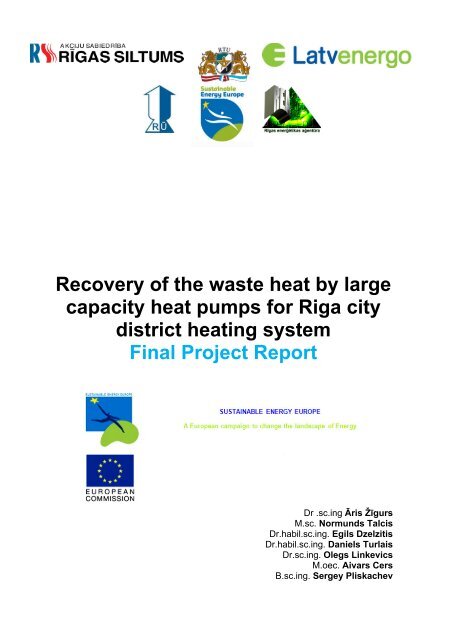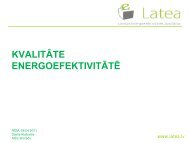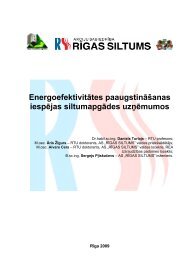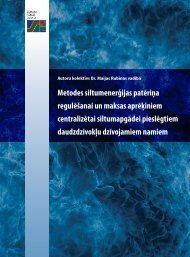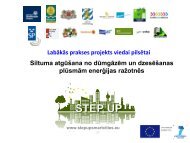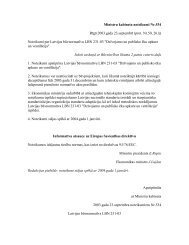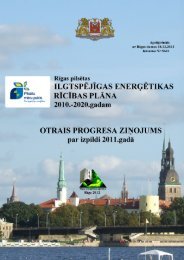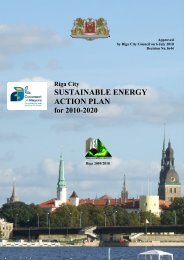Recovery of the waste heat by large capacity heat pumps for Riga ...
Recovery of the waste heat by large capacity heat pumps for Riga ...
Recovery of the waste heat by large capacity heat pumps for Riga ...
Create successful ePaper yourself
Turn your PDF publications into a flip-book with our unique Google optimized e-Paper software.
<strong>Recovery</strong> <strong>of</strong> <strong>waste</strong> <strong>heat</strong> <strong>by</strong> <strong>large</strong> <strong>capacity</strong> <strong>heat</strong> <strong>pumps</strong> <strong>for</strong> <strong>Riga</strong> city 5(26)district <strong>heat</strong>ing systempump / chiller. That <strong>heat</strong> is provided <strong>by</strong> DHP own steam boiler. Total cost <strong>for</strong> <strong>the</strong>project is amounted to 696 665 EUR.Picture No 2. Layout <strong>of</strong> <strong>the</strong> <strong>heat</strong> pump connectionTaking into account <strong>the</strong> constantly rising prices <strong>for</strong> natural gas, and implyingits annual consumption savings to <strong>the</strong> 842,000 m 3 , <strong>the</strong> project is expected to repayin three years. The payback period will be accelerated <strong>by</strong> <strong>the</strong> state implementedexcise tax on <strong>the</strong> natural gas, which is also expected to rise in coming years. Inaddition to <strong>the</strong> mentioned above, <strong>the</strong> project will save annually about 1580 CO 2emission quotas and reduce <strong>the</strong> consumption <strong>of</strong> chemically treated water <strong>for</strong> atleast 30%. The technical solution <strong>of</strong> <strong>heat</strong> pump / chiller implementation is specifiedin <strong>the</strong> picture No2, see abowe.Brief description <strong>of</strong> <strong>the</strong> CHPCurrent equipment:- Gas turbine Rolls Royce RB 211-24GT, 31,52 MW el ;- Heat recovery steam generator Transelektro Power 63 T/h, 67 bar;- Steam turbine B+V Industrietechnick MARC 4-H01, 16 MW el ;- Steam boiler Vapor, 12 t/h, 13 bar;- An absorption chiller BROAD BDS183X0.4-65/47-29/55-300-Fb-Mb.The total installed <strong>capacity</strong> <strong>of</strong> <strong>the</strong> CHP equipment is 48 MW el and 48 MW th(without an absorption chiller), and along with working at full <strong>capacity</strong> chiller is 53MWth.After <strong>the</strong> CHP erection, during <strong>the</strong> <strong>heat</strong>ing season water boilers operate inparallel with <strong>the</strong> CHP and in <strong>the</strong> summer time are in a state <strong>of</strong> reserve.
<strong>Recovery</strong> <strong>of</strong> <strong>waste</strong> <strong>heat</strong> <strong>by</strong> <strong>large</strong> <strong>capacity</strong> <strong>heat</strong> <strong>pumps</strong> <strong>for</strong> <strong>Riga</strong> city 12(26)district <strong>heat</strong>ing systemtowers. When <strong>the</strong> ambient temperatures are below -10°C and <strong>the</strong>re is anincrease in <strong>the</strong> return water temperature, <strong>for</strong> <strong>the</strong> cooling providing it isnecessary to consume a much greater amount <strong>of</strong> <strong>heat</strong> energy in <strong>the</strong> <strong>for</strong>m <strong>of</strong>steam. The number <strong>of</strong> steam consumed <strong>for</strong> cooling <strong>of</strong> <strong>the</strong> same amount <strong>of</strong>energy at <strong>the</strong> min and max T2 differs up to 100%.3. The important point is <strong>the</strong> load condition <strong>of</strong> <strong>the</strong> <strong>heat</strong> pump/chiller. Dependingon <strong>the</strong> principle <strong>of</strong> <strong>the</strong> cogeneration plant, <strong>the</strong> unit can be designed <strong>for</strong> workduring <strong>the</strong> <strong>heat</strong>ing season only or also in <strong>the</strong> summertime with <strong>the</strong> low <strong>heat</strong>loads. In <strong>the</strong> summertime it would be efficiently to use steam extraction from<strong>the</strong> steam turbine. In Latvia <strong>the</strong> duration <strong>of</strong> <strong>the</strong> <strong>heat</strong>ing season in average isabout 5200 hours per year. The ability to provide <strong>the</strong> <strong>heat</strong> pump working atfull <strong>capacity</strong> beyond <strong>the</strong> <strong>heat</strong>ing period falls very rarely; usually CHP <strong>heat</strong>load in <strong>the</strong> summer period is only about 12% comparing to <strong>the</strong> loads <strong>of</strong> <strong>the</strong><strong>heat</strong>ing season and in result <strong>the</strong> <strong>heat</strong> pump’s <strong>heat</strong> reduces <strong>the</strong> power output<strong>of</strong> <strong>the</strong> CHP. In our case, <strong>the</strong> installed <strong>heat</strong> pump is intended to be usedprimarily in <strong>the</strong> <strong>heat</strong>ing season time.4. Extreme important is to make <strong>the</strong> correct choice <strong>of</strong> <strong>the</strong> critical parameters. Inour case <strong>the</strong> temperature a cooling loop should to provide is +29°C (<strong>the</strong>optimal temperature range <strong>of</strong> 26-27°C). The <strong>capacity</strong> <strong>of</strong> <strong>the</strong> <strong>heat</strong> pump/chilleris limited <strong>by</strong> <strong>the</strong> maximum <strong>heat</strong> load, which is defined <strong>by</strong> <strong>the</strong> installation <strong>of</strong><strong>the</strong> parameters guaranteed. This temperature at <strong>the</strong> outlet <strong>of</strong> <strong>the</strong> <strong>heat</strong> <strong>pumps</strong>hould not be lower than <strong>the</strong> expected maximum T2, o<strong>the</strong>rwise <strong>the</strong>re mightbe a need <strong>for</strong> <strong>the</strong> compensation <strong>of</strong> <strong>the</strong> insufficient cooling <strong>capacity</strong> at high T2.5. Steam condensation problem. Usually <strong>for</strong> <strong>the</strong> needs <strong>of</strong> CHP it is used <strong>the</strong>steam with <strong>the</strong> high quality standards; <strong>for</strong> a boiler house own needs, in turn, itis used <strong>the</strong> lower quality steam, and <strong>the</strong> mixing or switching from <strong>the</strong> onetype <strong>of</strong> carrier to ano<strong>the</strong>r could be a problem in result.6. When <strong>the</strong> <strong>heat</strong> pump is in <strong>the</strong> continuous operation mode and in case <strong>of</strong>absence <strong>of</strong> <strong>the</strong> <strong>heat</strong> insulation, <strong>the</strong> significant <strong>heat</strong> loses can occur. Carriedout <strong>heat</strong> pump <strong>the</strong>rmograph had helped to improve significantly its <strong>the</strong>rmalinsulation, <strong>the</strong>re<strong>by</strong> increasing equipment efficiency, reduce <strong>the</strong> roomtemperature and reduce <strong>the</strong> amount <strong>of</strong> <strong>the</strong> <strong>heat</strong> losses.7. The most sensitive element <strong>of</strong> <strong>the</strong> project is <strong>the</strong> natural gas price. The pricerise faster payback, and in our case, taking into account <strong>the</strong> current highprices, it is extremely important.Fur<strong>the</strong>r studiesAs an effective solution to reduce <strong>the</strong> amount <strong>of</strong> <strong>the</strong> consumed steam <strong>for</strong> <strong>the</strong>cooling process at ambient temperatures below -10°C and <strong>the</strong> return network<strong>heat</strong>ing water temperatures above +47°C <strong>the</strong> boiler’s air <strong>heat</strong>er utilization ispossible.Thus, all <strong>the</strong> <strong>heat</strong> energy <strong>for</strong> <strong>the</strong> selection <strong>of</strong> which it is necessary to spend alot <strong>of</strong> steam, could be used <strong>for</strong> <strong>the</strong> air <strong>heat</strong>ing with a standard <strong>heat</strong>er. In our casewe will study <strong>the</strong> possibility to cool <strong>the</strong> return water or <strong>the</strong> technological water <strong>of</strong> <strong>the</strong>CHP with <strong>the</strong> standard air <strong>heat</strong>ers in two air ducts <strong>of</strong> <strong>the</strong> boiler KVGM-100. Thepicture No 8 shows a conventional air <strong>heat</strong>er, which can be adapted as a distric<strong>the</strong>ating return water cooler to <strong>the</strong> effective temperature range.
<strong>Recovery</strong> <strong>of</strong> <strong>waste</strong> <strong>heat</strong> <strong>by</strong> <strong>large</strong> <strong>capacity</strong> <strong>heat</strong> <strong>pumps</strong> <strong>for</strong> <strong>Riga</strong> citydistrict <strong>heat</strong>ing system13(26)Picture № 8. A conventional air <strong>heat</strong>er КPB-12 <strong>for</strong> <strong>the</strong> boiler KVGM-100The mentioned above boiler is already equipped with a condensingeconomizer, which enables boiler efficiency increasing higher than 100%(corresponding to <strong>the</strong> lowest <strong>heat</strong>ing value <strong>of</strong> <strong>the</strong> natural gas), thus making studyeven more actual.This improvement would provide an opportunity to reduce steam consumption<strong>for</strong> 0,5 t/h at an average and increase <strong>the</strong> boiler efficiency up to 0,5%, which atmean seasonal load 80-90 MW is quite a remarkable value.In <strong>the</strong> <strong>for</strong>eseeable future, <strong>the</strong> obtained experience is intended to apply in <strong>the</strong>geo<strong>the</strong>rmal projects implementation, which, in turn, without thorough understanding<strong>of</strong> <strong>the</strong> <strong>heat</strong> pump technology is absolutely impossible.Projects under developmentDuring <strong>the</strong> project implementation has been evaluated future projects. As <strong>the</strong> mostattractive locations <strong>for</strong> coming years have been identified <strong>the</strong> following locations: <strong>Riga</strong> Combine Heat Power plant (CHP)-1; <strong>Riga</strong> CHP 2; Daugavgriva Biological sewage water treatment plant.Both power plants have similarities with <strong>the</strong> already realized project and biologicalsewage water treatment plant project type has analogues in <strong>the</strong> nearestneighbouring countries. Due to that <strong>the</strong> subject has <strong>the</strong> high priority; <strong>Riga</strong> TechnicalUniversity engaged students and scientists in <strong>the</strong> research work. As an outcomecame three bachelor diploma works dedicated <strong>for</strong> all three subjects, as well aspublication prepared <strong>by</strong> Latvenergo employees in local technical journal . For moredetailed in<strong>for</strong>mation see sources ( 9 ; 10; 11; 12) and presented in<strong>for</strong>mation below.Installation <strong>of</strong> <strong>heat</strong> pump in <strong>the</strong> <strong>Riga</strong> CHP1Brief description <strong>of</strong> <strong>Riga</strong> CHP 1<strong>Riga</strong> CHP-1 is combined cycle cogeneration power plant with installed netelectric <strong>capacity</strong> 144 MW and <strong>heat</strong> <strong>capacity</strong> 490 MW, including 348 MW from <strong>heat</strong>only boilers.
<strong>Recovery</strong> <strong>of</strong> <strong>waste</strong> <strong>heat</strong> <strong>by</strong> <strong>large</strong> <strong>capacity</strong> <strong>heat</strong> <strong>pumps</strong> <strong>for</strong> <strong>Riga</strong> city 14(26)district <strong>heat</strong>ing systemThe investment decision about reconstruction <strong>of</strong> <strong>Riga</strong> CHP-1 was supported<strong>by</strong> several pre-feasibility and feasibility studies. The EPC turnkey contract <strong>for</strong> <strong>the</strong>implementation <strong>of</strong> this project was placed with <strong>the</strong> Siemens industrial gas turbinebusiness in Sweden “Demag Delaval Industrial Turbomachinery AB” (earlierALSTOM Power Sweden AB) on 30 June 2003. The power plant wascommissioned on 10 November 2005. All <strong>the</strong> existing CHP units and HOBs weredecommissioned.Capacity <strong>of</strong> <strong>the</strong> new CCGT CHP units was chosen in accordance withsummer <strong>heat</strong>ing loads. That is why it operates solely in cogeneration mode. Thenew CCGT plant supplies district <strong>heat</strong>ing to <strong>the</strong> Right bank <strong>heat</strong>ing networks <strong>of</strong><strong>Riga</strong>. The main components <strong>of</strong> <strong>the</strong> CCGT plant are two natural gas fired (singlefuel) 43 MW GTX-100 gas turbines equipped with dry low NO x combustion systems,two <strong>heat</strong> recovery steam generators with supplementary gas firing and one 54 MWback pressure district <strong>heat</strong>ing steam turbine MP 24. In addition three new HOBsKVGM-100 (produced in Russia), burning natural gas and diesel fuel with total <strong>heat</strong><strong>capacity</strong> 348 MW are installed.The rehabilitation <strong>of</strong> <strong>Riga</strong> CHP-1 allowed reducing significantly <strong>the</strong>concentration and emission <strong>of</strong> harmful substances in <strong>the</strong> atmosphere in comparisonto <strong>the</strong> old plant (approximately <strong>by</strong> two times). Emission <strong>of</strong> sulphur oxide, vanadiumoxide and solid particles are prevented completely, but NO x emission is significantlylower than <strong>the</strong> approved normative <strong>for</strong> <strong>Riga</strong> CHP-1.Picture № 9. Technological scheme <strong>of</strong> <strong>Riga</strong> CHP-1<strong>Riga</strong> CHP‐1 <strong>heat</strong> pump projectInstallation <strong>of</strong> absorption <strong>heat</strong> pump with gas burner was selected as <strong>the</strong>feasible option to improve efficiency <strong>of</strong> <strong>Riga</strong> CHP-1, to increase its <strong>heat</strong> <strong>capacity</strong>, aswell as availability and flexibility <strong>of</strong> main generating equipment. Heat pump will usea low potential <strong>heat</strong> <strong>of</strong> cogeneration unit’s cooling system to produce <strong>heat</strong> energy<strong>for</strong> district <strong>heat</strong>ing system <strong>of</strong> <strong>Riga</strong>.Overall <strong>heat</strong> <strong>capacity</strong> <strong>of</strong> <strong>the</strong> <strong>heat</strong> pump is considered to be 11.6 MW, whileutilised latent <strong>heat</strong> <strong>of</strong> <strong>the</strong> cooling system <strong>of</strong> cogeneration unit is estimated to be 4.46MW. According to preliminary calculations, <strong>the</strong> overall project cost could beapproximately 1.2 million Ls.
<strong>Recovery</strong> <strong>of</strong> <strong>waste</strong> <strong>heat</strong> <strong>by</strong> <strong>large</strong> <strong>capacity</strong> <strong>heat</strong> <strong>pumps</strong> <strong>for</strong> <strong>Riga</strong> city 15(26)district <strong>heat</strong>ing systemImplementation <strong>of</strong> <strong>the</strong> Project would allow to reduced natural gasconsumption, reduce CO 2 emissions and increase <strong>the</strong> output <strong>of</strong> <strong>the</strong> power plant.Parameters <strong>of</strong> <strong>the</strong> cooling system <strong>of</strong> <strong>Riga</strong> CHP‐1Steam turbine MP24DH <strong>of</strong> <strong>Riga</strong> CHP-1 is a backpressure turbine. That iswhy it does not have a condenser and a cooling system with cooling towers. All <strong>the</strong>low pressure steam after <strong>the</strong> turbine is delivered into district <strong>heat</strong>ing water <strong>heat</strong>ers.This cogeneration cycle allow to achieve a very high fuel utilisation efficiency <strong>of</strong>87.7%. But <strong>the</strong> only <strong>heat</strong> available <strong>for</strong> fur<strong>the</strong>r improvement <strong>of</strong> cycle efficiency is <strong>the</strong><strong>heat</strong> from closed cooling system <strong>of</strong> main generation equipment (2 compressors, 2gas turbines (GT), 1 steam turbine (ST), 3 electric generators, 2 <strong>heat</strong> recoverysteam generators (HRSG) and o<strong>the</strong>r auxiliary equipment).It might be feasible to install absorption <strong>heat</strong> pump to use latent <strong>heat</strong> from <strong>the</strong>cooling system <strong>of</strong> cogeneration unit in <strong>Riga</strong> CHP-1. The key criteria and limitation<strong>for</strong> selection <strong>of</strong> optimal <strong>capacity</strong> <strong>of</strong> <strong>heat</strong> pump are available low potential <strong>heat</strong> from acooling agent and necessary high potential <strong>heat</strong> from external source (steam, hotwater or combustion gases). In case <strong>of</strong> <strong>Riga</strong> CHP-1 it is recommended to use anabsorption <strong>heat</strong> pump with integrated gas burner (as a source <strong>of</strong> high potential<strong>heat</strong>).Input data <strong>for</strong> calculation <strong>of</strong> <strong>heat</strong> pump <strong>capacity</strong> are input/output parametersand flow rate <strong>of</strong> cooling agent Temper-30, as well as calculated <strong>capacity</strong> <strong>of</strong> acooling circuit <strong>for</strong> two possible cases: 1 GT+1 HRSG + TT - when <strong>the</strong> half <strong>of</strong>cogeneration unit is in operation and 2 GT+2 HRSG + TT, when all equipment is inoperation.According to <strong>the</strong> design data, <strong>capacity</strong> <strong>of</strong> a cooling circuit is 8.6 MW in caseall <strong>the</strong> equipment <strong>of</strong> <strong>Riga</strong> CHP-1 is in operation and 4.45 MW in case only half <strong>of</strong>cogeneration unit is in operation (Table 2).Table 2 Design data <strong>of</strong> <strong>Riga</strong> CHP-1 cooling systemTotal <strong>heat</strong>, MWComponent 2 GT+2 HRSG+TT 1 GT+1 HRSG+TTNatural gas compressor cooler 2.850 1.425Gas turbine GTX 1 generator cooler 0.688 0.688Gas turbine GTX 1 lubrication cooler 1.060 1.060Gas turbine GTX 2 generator cooler 0.688 -Gas turbine GTX 2 lubrication cooler 1.060 -Steam turbine generator cooler 0.740 0.370Steam turbine MP24 lubrication cooler 1.100 0.550Heat recovery steam generators 1 & 2 sample coolers 0.116 0.058Auxiliary equipment coolers 0.300 0.300Total 8.602 4.451Water temperature, °C 37 48Calculations <strong>of</strong> main parameters <strong>of</strong> a <strong>heat</strong> pump are per<strong>for</strong>med based on realdata from <strong>Riga</strong> CHP-1 control and monitoring system (CMS). Operational statistic<strong>for</strong> <strong>the</strong> October 2010 was used. One gas turbine, one <strong>heat</strong> recovery boiler andsteam turbine (1 GT+1 HRSG+TT) were in operation at that period. Thetrans<strong>for</strong>mation coefficient (COP) <strong>for</strong> one stage absorption <strong>heat</strong> pump was assumedζ= 1.6. Calculated parameters are shown in Table 3.
<strong>Recovery</strong> <strong>of</strong> <strong>waste</strong> <strong>heat</strong> <strong>by</strong> <strong>large</strong> <strong>capacity</strong> <strong>heat</strong> <strong>pumps</strong> <strong>for</strong> <strong>Riga</strong> citydistrict <strong>heat</strong>ing system16(26)Table 3 Calculated parameters <strong>of</strong> <strong>Riga</strong> CHP-1 <strong>heat</strong> pump# Parameters 1 GT+1HRSG +TTPartial load2 GT+2HRSG +TTNominalload1 Inlet temperature <strong>of</strong> a cooling circuit 27 30 482 Outlet temperature <strong>of</strong> a cooling circuit 23 23 373 Nominal flow rate <strong>of</strong> a circulating pump, m 3 /h 813 813Density <strong>of</strong> cooling agent Temper-3034 at average temperature 25°C, t/m1.17 1.175 Nominal flow rate <strong>of</strong> a circulating pump, t/h 951 9516 Rotation speed <strong>of</strong> a circulating pump, % <strong>of</strong> nominal load 88% 89% 100%7 Flow rate <strong>of</strong> a circulating pump at partial loads, t/h =(5)*(6)/100) 837 847 957.68 Flow rate <strong>of</strong> a circulating pump, kg/s (=(7)/3.6 233 235 2669 Specific <strong>heat</strong> <strong>capacity</strong> <strong>of</strong> Tempera-30 (C p ), kJ/(kg*K) 3.15 3.15 3.1510 Necessary cooling <strong>capacity</strong>, MW (=(9)*(8)*((1)-(2))/1000) 2.93 5.19 8.8211 Latent <strong>heat</strong>, MW (based on (10)) 3.0 6.0 9.012 Heat input <strong>of</strong> a <strong>heat</strong> pump, MW (=latent <strong>heat</strong>/0.6) 5.0 10.0 15.013 Heat output <strong>of</strong> a <strong>heat</strong> pump, MW (=(11)+(12)) 8.0 16.0 24.0Absorption <strong>heat</strong> pump with integrated gas burnerAbsorption <strong>heat</strong> pump with integrated gas burner might help to solve <strong>the</strong>problem with inefficient operation <strong>of</strong> cogeneration unit in certain regimes. Usuallysuch regimes are observed in summer, when half <strong>of</strong> cogeneration unit is inoperation (1 GT+1 HRSG + TT) with nominal <strong>capacity</strong> (about 64 MW), but <strong>heat</strong>demand is increasing, <strong>for</strong> example <strong>for</strong> 5 MW. In this case, <strong>the</strong> operators are <strong>for</strong>cedto switch on one <strong>heat</strong> only boiler at its minimum <strong>capacity</strong>, which is 11 MW. It meansthat cogeneration unit <strong>capacity</strong> shall be decreased <strong>by</strong> 6 MW with fur<strong>the</strong>r losses fromreduction <strong>of</strong> electricity and <strong>heat</strong> production in cogeneration mode.Picture № 10. Absorption <strong>heat</strong> pump with integrated gas burnerFor <strong>the</strong> absorption <strong>heat</strong> pump, a latent <strong>heat</strong> from <strong>the</strong> cooling circuit <strong>of</strong> a <strong>Riga</strong>CHP-1 cogeneration unit is used to produce a useful <strong>heat</strong> <strong>for</strong> <strong>the</strong> district <strong>heat</strong>ingsystem <strong>of</strong> <strong>Riga</strong> (Picture 10). Heat pump shall be connected in parallel tocogeneration unit and <strong>heat</strong> only boilers. The maximum output <strong>capacity</strong> <strong>of</strong> a <strong>heat</strong>
<strong>Recovery</strong> <strong>of</strong> <strong>waste</strong> <strong>heat</strong> <strong>by</strong> <strong>large</strong> <strong>capacity</strong> <strong>heat</strong> <strong>pumps</strong> <strong>for</strong> <strong>Riga</strong> city 17(26)district <strong>heat</strong>ing systempump is selected to be equal to minimum <strong>capacity</strong> <strong>of</strong> a <strong>heat</strong> only boiler <strong>of</strong> <strong>Riga</strong>CHP-1, which is approximately 11 MW.Table 4 Possible operation regimes <strong>of</strong> <strong>the</strong> <strong>heat</strong> pumpCalculatedregime,11.6 MW1 GT+1 HRSG + TTadditional 3.3 MW2 GT+2 HRSG + TTadditional 8.3 MWParametersNatural gas consumption <strong>of</strong> a <strong>heat</strong> pumpat LHV Q d z = 8300 kcal/m 3 , m 3 /h 710 200 510District <strong>heat</strong>ing (DH) water consumption, m 3 /h 300 87 300Cooling agent consumption, m 3 /h 957 250 705Return DH water temperature, °C 50 40Supply DH water temperature, °C 90 70Temper-30 temperature in <strong>the</strong> inlet, °C 40 25 30 25 30Temper-30 temperature in <strong>the</strong> outlet, °C 35 20 25 30 25Loading <strong>of</strong> <strong>heat</strong> pump, % from nominal 90 60 100 60 100Additional <strong>heat</strong> <strong>capacity</strong>, MW 10.4 2.0 3.3 5 8.3Electricity self consumption, kW 31.0 9.5 21.5For simplification <strong>of</strong> calculations, let us assume <strong>the</strong> district <strong>heat</strong>ingparameters (return/supply water temperature) correspondingly 40/70 °C. Dependingon <strong>the</strong> temperature <strong>of</strong> a cooling agent in <strong>the</strong> outlet <strong>of</strong> <strong>the</strong> <strong>heat</strong> pump and assuming<strong>the</strong> temperature drop in <strong>the</strong> <strong>heat</strong> pump around 5 °C, its <strong>capacity</strong> could bedetermined. Possible operation regimes <strong>of</strong> <strong>the</strong> <strong>heat</strong> pump and its <strong>capacity</strong>,depending on <strong>the</strong> temperature <strong>of</strong> a cooling agent are shown in <strong>the</strong> Table 4.One <strong>of</strong> <strong>the</strong> key assumptions - <strong>the</strong> <strong>heat</strong> pump is able to operate with minimum<strong>heat</strong> <strong>capacity</strong> <strong>of</strong> 1 MW and is flexible in <strong>the</strong> range from 1 MW to 11 MW. Overall<strong>heat</strong> <strong>capacity</strong> is 11.6 MW, while latent <strong>heat</strong> (<strong>heat</strong> necessary <strong>for</strong> <strong>the</strong> cooling system<strong>of</strong> cogeneration unit) is 4.46 MW.Planned per<strong>for</strong>mance <strong>of</strong> <strong>the</strong> <strong>heat</strong> pumpEnergy generation program is calculated <strong>for</strong> two possible options: with andwithout <strong>heat</strong> pump (HP) installation (Table 5). Comparing <strong>the</strong>se options, it ispossible to conclude: as <strong>the</strong> result <strong>of</strong> installation <strong>of</strong> <strong>heat</strong> pump, <strong>heat</strong> production <strong>of</strong><strong>heat</strong> only boilers will reduce <strong>by</strong> 38.2 GWh, while output <strong>of</strong> cogeneration unit willincrease <strong>by</strong> 12.3 GWh. Consequently, absorption <strong>heat</strong> pump will produce 26.1 GWh<strong>of</strong> <strong>heat</strong> energy.At <strong>the</strong> same time, electricity production <strong>of</strong> <strong>Riga</strong> CHP-1 will increase <strong>by</strong> 12.1GWh. Installation <strong>of</strong> <strong>heat</strong> pump allow to enhance fuel efficiency <strong>of</strong> <strong>Riga</strong> CHP-1.Table 5 Energy generation program <strong>for</strong> two options: with and without <strong>heat</strong> pumpMWhHeat production Power production Fuel consumptionwithout HP With HP without HP With HP without HP With HP<strong>Riga</strong> CHP-1 666 590 678 881 656 818 668 906 1 472 199 1 499 195<strong>Riga</strong> CHP-2 1 852 128 1 851 963 2 402 797 2 402 649 4 932 944 4 932 590Heat only boilers 148 341 110 107 - - 160 634 118 835Heat pump (HP) - 26 127 - - - 17 386Total 2 667 058 2 667 078 3 059 616 3 071 555 6 565 777 6 568 006During <strong>the</strong> <strong>heat</strong>ing season, <strong>heat</strong> pump starts to operate only at temperaturebelow -8 ºC, when cogeneration units <strong>of</strong> <strong>Riga</strong> CHP-1 and CHP-2 are fully loaded atnominal <strong>capacity</strong>. Practically, <strong>heat</strong> pump allows to replace 11.6 MW <strong>of</strong> <strong>heat</strong> onlyboiler <strong>capacity</strong>. In comparison to o<strong>the</strong>r <strong>heat</strong> sources, its contribution in <strong>heat</strong> balanceis not significant. (Picture 11).
<strong>Recovery</strong> <strong>of</strong> <strong>waste</strong> <strong>heat</strong> <strong>by</strong> <strong>large</strong> <strong>capacity</strong> <strong>heat</strong> <strong>pumps</strong> <strong>for</strong> <strong>Riga</strong> citydistrict <strong>heat</strong>ing system18(26)1200RTEC-2-1 RTEC-1 SS RTEC-2-2 ŪSK1000800MW600400200stundas01 49 97 145 193 241 289 337 385 433 481 529 577 625 673 721Picture № 11. Heat production <strong>for</strong> <strong>the</strong> option with installation <strong>of</strong> <strong>the</strong> <strong>heat</strong> pump (January)During <strong>the</strong> summer period, <strong>the</strong> <strong>heat</strong> pump shall partly or entirely replace <strong>heat</strong>only boilers, providing better utilisation <strong>of</strong> cogeneration unit (Picture 12).Consequently, electricity and <strong>heat</strong> production in cogeneration mode shall increase.120RTEC-1 SS RTEC-2-1 RTEC-2-2 ŪSK10080MW6040200stundas1 49 97 145 193 241 289 337 385 433 481 529 577 625 673 721Picture № 11. Heat production <strong>for</strong> <strong>the</strong> option with installation <strong>of</strong> <strong>the</strong> <strong>heat</strong> pump (July)Economic evaluation <strong>of</strong> <strong>the</strong> projectInstallation <strong>of</strong> 11.6 MW absorption <strong>heat</strong> pump with integrated gas burnerevaluated cost is close to 1.23 million Ls, including equipment, construction andcommissioning cost.According to economic evaluation, installation <strong>of</strong> <strong>heat</strong> pump shall pay <strong>of</strong>f in11 years, while <strong>the</strong> Net Present Value (NPV) <strong>for</strong> <strong>the</strong> 10th year <strong>of</strong> operation shall be672 thousands Ls, but Internal Rate <strong>of</strong> Return (IRR) 14.4%.
<strong>Recovery</strong> <strong>of</strong> <strong>waste</strong> <strong>heat</strong> <strong>by</strong> <strong>large</strong> <strong>capacity</strong> <strong>heat</strong> <strong>pumps</strong> <strong>for</strong> <strong>Riga</strong> citydistrict <strong>heat</strong>ing system19(26)Cooling systemLocation <strong>of</strong> <strong>heat</strong> pumpPicture № 11. Location <strong>of</strong> absorption <strong>heat</strong> pump in <strong>Riga</strong> CHP-1Comparing to <strong>the</strong> Imanta DHP, <strong>Riga</strong> CHP1 and CHP2 are working in <strong>the</strong>same DH network, as well as cogeneration penetration level is considerably higher,which in particular case create problem with commercially acceptable repaymentperiod. Project can be feasible if EU co-financing would be available.Potential location <strong>of</strong> a <strong>heat</strong> pump in <strong>the</strong> territory <strong>of</strong> <strong>Riga</strong> CHP-1 could benear<strong>by</strong> to <strong>the</strong> administration building and control room. The benefit <strong>of</strong> this location,is that it is free <strong>of</strong> any construction and communications.Picture № 11. Cooling system <strong>of</strong> <strong>Riga</strong> CHP-1
<strong>Recovery</strong> <strong>of</strong> <strong>waste</strong> <strong>heat</strong> <strong>by</strong> <strong>large</strong> <strong>capacity</strong> <strong>heat</strong> <strong>pumps</strong> <strong>for</strong> <strong>Riga</strong> city 20(26)district <strong>heat</strong>ing systemAll chapter material is based on in<strong>for</strong>mation and initial visual materials presented insource No 11 and 12.Installation <strong>of</strong> <strong>heat</strong> pump in <strong>the</strong> new power unit <strong>of</strong> <strong>Riga</strong> CHP-2Brief description <strong>of</strong> <strong>Riga</strong> CHP 2.<strong>Riga</strong> CHP-2 is <strong>the</strong> <strong>large</strong>st combined <strong>heat</strong> and power plant in Latvia. Its first water<strong>heat</strong>ingboilers were launched in <strong>the</strong> period from 1973 to 1992 and four powergeneratingsteam boilers and four steam turbines (CHPP’s power-generatingsection) – from 1975 to 1979. Presently, <strong>the</strong> installed electrical <strong>capacity</strong> <strong>of</strong> TEC-2 is330 MWel and its <strong>the</strong>rmal <strong>capacity</strong> – 1148 MWth. As planned construction <strong>of</strong> a newnatural gas full combine cycle power unit at TEC-2 completed at <strong>the</strong> end <strong>of</strong> 2008.As a result, TEC-2 became <strong>the</strong> most advanced electricity and <strong>heat</strong> power plant in<strong>the</strong> Baltic region with increased overall reliability <strong>of</strong> electricity supply in Latvia.After <strong>the</strong> construction <strong>of</strong> <strong>the</strong> first modern combine cycle power unit, <strong>the</strong> generation<strong>of</strong> electricity in cogeneration mode increased from 820 GWh per year on average to2200 GWh per year on average, providing Latvia with approximately 1400 GWh <strong>of</strong>additional electricity per year. Coming to <strong>the</strong> final end ano<strong>the</strong>r analogous high<strong>capacity</strong>power unit, commissioning is expected in 2012. As a result, will be possibleto close down completely <strong>the</strong> existing outdated less efficient power-generatingsection <strong>of</strong> TEC-2. As a result <strong>of</strong> this modernization, significant increase in <strong>the</strong> powerplant’s electrical <strong>capacity</strong> and electricity generation amount is expected in 2012.Taking in account that combine cycle emits remarkable amount <strong>of</strong> low grade <strong>heat</strong>.In 2009, TEC-2 generated 909 GWh <strong>of</strong> electricity. <strong>Riga</strong> CHP2 is <strong>the</strong> biggestpower plant <strong>of</strong> <strong>Riga</strong> connected to <strong>the</strong> <strong>Riga</strong> right bank district <strong>heat</strong>ing network.<strong>Riga</strong> CHP‐2 <strong>heat</strong> pump projectProject evaluation has been done in a bachelor diploma work. The main task<strong>of</strong> project <strong>for</strong> installation <strong>of</strong> <strong>heat</strong> pump in <strong>the</strong> new power unit <strong>of</strong> <strong>Riga</strong> CHP-2 was toconsider <strong>the</strong> best possible ways <strong>of</strong> introducing a <strong>heat</strong> pump technology with <strong>the</strong> aimto utilize medium or low grade <strong>waste</strong> <strong>heat</strong> on <strong>the</strong> new power unit CHP-2, which wascomissioned in 2009. Project examines and compares <strong>the</strong> CHP-2 unit <strong>heat</strong> pumptechnical and economic efficiency. The main two types <strong>of</strong> <strong>heat</strong> <strong>pumps</strong>: <strong>the</strong>absorption and compression has been examined.The aim <strong>of</strong> <strong>the</strong> work - creating a cost-effective, energy-efficient <strong>heat</strong>ingsystem model <strong>for</strong> CHP-2, to ensure compliance with <strong>the</strong> <strong>heat</strong>ing load, usingcogeneration equipment connected <strong>heat</strong> <strong>pumps</strong>. The main requirement is to provide<strong>the</strong> <strong>heat</strong>ing needs <strong>by</strong> utilization <strong>of</strong> available low-potential <strong>heat</strong>.Evaluation <strong>of</strong> <strong>the</strong> project required deep dig in <strong>the</strong> basics <strong>of</strong> <strong>heat</strong> pump or chilleroperating principles, as well as revue <strong>of</strong> <strong>the</strong> plant design. The <strong>the</strong>rmodynamic cyclerequired <strong>the</strong> calculations to determine <strong>the</strong> main <strong>heat</strong>-pump parameters, as well aswas carried out, namely, <strong>heat</strong> trans<strong>for</strong>mation ratio, specific fuel consumption <strong>of</strong> 1kW <strong>of</strong> <strong>heat</strong> and <strong>heat</strong> pump <strong>capacity</strong> <strong>of</strong> basic elements.Thesis includes <strong>the</strong>rmal engineering calculations <strong>of</strong> <strong>the</strong> basic design and hydrauliccalculation <strong>of</strong> <strong>the</strong> absorption <strong>heat</strong> pump, as well as held exergy analysis <strong>of</strong> <strong>heat</strong>pump installation.
<strong>Recovery</strong> <strong>of</strong> <strong>waste</strong> <strong>heat</strong> <strong>by</strong> <strong>large</strong> <strong>capacity</strong> <strong>heat</strong> <strong>pumps</strong> <strong>for</strong> <strong>Riga</strong> citydistrict <strong>heat</strong>ing system21(26)Picture No 12 CHP-2 new block <strong>heat</strong> pump connection schemeAs a source <strong>of</strong> <strong>heat</strong> <strong>for</strong> <strong>heat</strong> pump generator <strong>heat</strong>ing was selected extraction steamfrom combine cycle steam turbine and low grade <strong>heat</strong> from open type coolingtowers is planned to use as source <strong>of</strong> energy supplied to <strong>the</strong> evaporator <strong>of</strong>absorption <strong>heat</strong> pump. The main <strong>heat</strong> recovery scheme available in <strong>the</strong> picture12.Open cooling tower system <strong>of</strong> CHP2 is presented in <strong>the</strong> picture 13.Picture No 13 CHP-2 <strong>the</strong> new combine cycle cooling tower systemThe main conclusions about <strong>the</strong> reasons to implement <strong>heat</strong> pump installation <strong>for</strong>CHP-2 with <strong>the</strong> aim to reduce emissions and reach extra ecological effects are asfollows:
<strong>Recovery</strong> <strong>of</strong> <strong>waste</strong> <strong>heat</strong> <strong>by</strong> <strong>large</strong> <strong>capacity</strong> <strong>heat</strong> <strong>pumps</strong> <strong>for</strong> <strong>Riga</strong> city 22(26)district <strong>heat</strong>ing system1. Implementation <strong>of</strong> project can ensure reduction <strong>of</strong> chemically treated water <strong>for</strong>16.502 t/annum due to reduced evaporation in cooling towers.2. Absorption <strong>heat</strong> pump project 10th year NPV= 1.465 mil Ls with existing prices<strong>for</strong> energy resources. Due to that starting from July 1 st 2011 <strong>for</strong> natural gas excisetax is applied, project rentability will be accelerated even more. The estimatedrepayment period is 3.3 year.3. The total planned cooling <strong>capacity</strong> is 2.24 MW, corresponding <strong>heat</strong>ing <strong>capacity</strong>5.2 MW.4. Total reduction <strong>of</strong> natural gas consumption <strong>for</strong> production <strong>of</strong> <strong>heat</strong> <strong>by</strong> recovered<strong>heat</strong> planned on a level <strong>of</strong> 1.159 mil m³/annum.5. Project anticipates using only part <strong>of</strong> low grade <strong>heat</strong> source. 2.24 recovered MWis only a small part <strong>of</strong> total 18 MW auxiliary cooling system capacities.6. As a problematic is possibility to have enough steam supply from non-combinecycle steam generation facilities close to <strong>heat</strong> pump installation.7. The steam extraction from steam turbine reduces electrical efficiency <strong>of</strong> CHP.8. The <strong>heat</strong> pump operation in non-<strong>heat</strong>ing season and during flooding periods iseconomically not liable.9. The commissioning <strong>of</strong> 2 nd new CHP block will reduce potential running hours <strong>of</strong><strong>heat</strong> pump due to full utilization <strong>of</strong> needed <strong>heat</strong> supply <strong>by</strong> cogeneration.More detailed business plan shall be worked out to evaluate <strong>the</strong> reasonability <strong>of</strong>installation <strong>of</strong> single, double or even triple unit with <strong>the</strong> aim to rise efficiency <strong>of</strong> plantand reduction <strong>of</strong> production costs.All chapter material is based on in<strong>for</strong>mation and initial visual materialspresented in source No 10.Due to that CHP-1 and CHP-2 are able to work in connected RIGA right bankdistrict <strong>heat</strong>ing network and in a case <strong>of</strong> network separation, <strong>the</strong> less cogenerationpenetration is in <strong>the</strong> network area <strong>of</strong> CHP-1, <strong>the</strong> CHP-1 is more beneficial on aeconomical means.Biological Water treatment plant Daugavgriva ProjectThe first water supply device in <strong>Riga</strong> was built in 1620. Initially all sewagewas discharged into natural reservoirs adjacent to <strong>the</strong> territory <strong>of</strong> <strong>Riga</strong> or within it.All city <strong>waste</strong>water is collected in <strong>the</strong> treatment plant Daugavgriva. It is treated anddischarged into <strong>Riga</strong> Bay 3 km <strong>of</strong>f <strong>the</strong> coast line. The Treatment plant 'Daugavgriva'was put into operation in 1991. The initial designed productivity <strong>of</strong> <strong>the</strong> plant was350,000 m3 per day.Picture No 14 The municipal <strong>waste</strong>water treatment plant <strong>of</strong> <strong>Riga</strong>.
<strong>Recovery</strong> <strong>of</strong> <strong>waste</strong> <strong>heat</strong> <strong>by</strong> <strong>large</strong> <strong>capacity</strong> <strong>heat</strong> <strong>pumps</strong> <strong>for</strong> <strong>Riga</strong> city 23(26)district <strong>heat</strong>ing systemThe Daugavgriva water biological treatment station (DWBTS) locates on <strong>Riga</strong> BuļļuIsland Dzintaru str.60 near <strong>the</strong> Baltic sea. Sewage waters collected from <strong>Riga</strong> andJurmala are pumped to DWBTS. Totally it serves <strong>for</strong> 850’000 inhabitants. The watertreatment design <strong>capacity</strong> <strong>of</strong> DWBTS is 350 th m³/day; however <strong>the</strong> real requestedload is 170’000m³/day.The DWBTS potential <strong>for</strong> <strong>heat</strong> pump/chillier installation has been elaborated<strong>by</strong> RĪGAS ŪDENS Ltd (RU) and RIGA TECHNICAL UNIVERSITY (RTU) scientists.During evaluation process <strong>the</strong> main three versions had detailed inspection. Versionsdiffer <strong>by</strong> energy production and <strong>heat</strong> pump/chillers’ installation. As a source <strong>for</strong>energy generation savage water is planned to use.In DWBTS as a source <strong>of</strong> high potential is planned to use excess <strong>heat</strong> from localCHP; auxiliary natural gas driven or woodchip steam boiler. All examined versionsdiffer <strong>by</strong> <strong>the</strong> auxiliary steam generation. Steam generation is possible <strong>by</strong> existingboilerhouse steam boilers DE-25-14-GM and DE -10-14-GM or <strong>by</strong> potentially newbi<strong>of</strong>uel (woodchips) boilerhouse. Each version more detailed evaluated followsbelow: Version 1: Heat pump installation <strong>for</strong> plant auxiliary needs, to cover <strong>the</strong> total<strong>heat</strong>ing <strong>capacity</strong> (October– April), when <strong>the</strong> existing CHP <strong>capacity</strong> do notcover all <strong>heat</strong>ing load and natural gas boiler is in operation to cover <strong>capacity</strong>requirements. Two subversions possible: Version1a: The <strong>heat</strong> pump installation in existing boiler house and with <strong>the</strong>auxiliary steam production <strong>by</strong> existing natural gas steam boilers. Version 1b: <strong>the</strong> <strong>heat</strong> pump located in a new bio fuel (woodchips) firedsteam boiler house. Version is presented in <strong>the</strong> picture No 15.Picture No 15 DWBTS <strong>heat</strong> pump installation with bio fuel boilerVersion 2: During <strong>the</strong> summer period excess <strong>heat</strong> from CHP to be deliveredto Daugavgriva DH plant network <strong>by</strong> new pipeline approximately 3.2km long.The main delivery <strong>of</strong> <strong>heat</strong> to network is planned mainly in non-<strong>heat</strong>ingseason.Version 3: <strong>the</strong> installation <strong>of</strong> two <strong>heat</strong> <strong>pumps</strong> with <strong>the</strong> aim to cover <strong>heat</strong>ingseason load <strong>for</strong> DWBTS and partial <strong>heat</strong> supply to Daugavgriva DH network,as well as optimization <strong>of</strong> existing CHP excess <strong>heat</strong> delivery to DH network insummer period. The serial connection <strong>of</strong> <strong>heat</strong> <strong>pumps</strong> has been chosen with
<strong>Recovery</strong> <strong>of</strong> <strong>waste</strong> <strong>heat</strong> <strong>by</strong> <strong>large</strong> <strong>capacity</strong> <strong>heat</strong> <strong>pumps</strong> <strong>for</strong> <strong>Riga</strong> city 24(26)district <strong>heat</strong>ing system<strong>the</strong> aim to lift <strong>the</strong> DH supply line temperature on an equal level with <strong>the</strong>Daugavgriva DH plant temperature graph. Two subversions possible: Version 3a: – <strong>the</strong> both <strong>heat</strong> <strong>pumps</strong> located in existing boiler house and usesauxiliary steam from existin steam boilers. Version 3b: <strong>the</strong> <strong>heat</strong> pump(s) located in new bi<strong>of</strong>uel boiler house.Detailed economical revue show that in <strong>the</strong> existing economical conditionsonly versions 1a and 1b have <strong>the</strong> lowest possible investment, in <strong>the</strong> result <strong>the</strong> bestpayback, as well as implementation is simple. Taking in account that evaluation isbased on unchanged price <strong>of</strong> energy resources, as well as in case 1a investment isless, <strong>the</strong> version 1a wins. However, used natural gas in version 1a is an additionalcost escalation risk factor. Version 1b has higher initial cost, but unplannedoperational cost escalation would be excluded. The repayment rate differencebetween <strong>the</strong> versions 1a and 1b are minor and version 1b is advisable as mostsustainable long term solution. In addition advised version is CO 2 neutral andattraction <strong>of</strong> potential EU funding <strong>for</strong> such projects can be available comparing with1a.Picture No 16 Temperature <strong>of</strong> refined water on DWBTS exit pipelineVersions 2; 3a and 3b are technically liable, but high investment costs make<strong>the</strong>m economically inefficient. Especially 3.2 km DH pipeline cost is too high toaf<strong>for</strong>d in particular economical conditions. Version 3b is <strong>the</strong> most favourable, if <strong>the</strong>pipeline cost is eliminated. As a driving <strong>for</strong>ce <strong>for</strong> <strong>heat</strong> pump installation in DWBTS isavailability <strong>of</strong> high volume (~9000 m³/h) <strong>of</strong> low grade <strong>heat</strong> in already cleaned water,even in <strong>heat</strong>ing season. In <strong>the</strong> picture 16 is presented obtained during <strong>the</strong> projectrefined water temperatures, which shows potential comparing to <strong>the</strong> earth <strong>heat</strong>based <strong>heat</strong> <strong>pumps</strong>. Realization <strong>of</strong> project version 1b is possible as <strong>for</strong> commercialproject with <strong>the</strong> discounted repayment period in less than 8 Years, annual savings<strong>of</strong> natural gas 841 nm³. Attraction <strong>of</strong> EU funding could give an addition benefits <strong>for</strong><strong>the</strong> project implementation. Be<strong>for</strong>e <strong>the</strong> project implementation <strong>the</strong> detailed businessplan shall be developed. Potential project realization can be in time period 2012-2015.All chapter material is based on in<strong>for</strong>mation and initial visual materials presented insource No 9.
<strong>Recovery</strong> <strong>of</strong> <strong>waste</strong> <strong>heat</strong> <strong>by</strong> <strong>large</strong> <strong>capacity</strong> <strong>heat</strong> <strong>pumps</strong> <strong>for</strong> <strong>Riga</strong> city 25(26)district <strong>heat</strong>ing systemFinal conclusionsThis first installation <strong>of</strong> absorption <strong>heat</strong> pump/chiller in Imanta DH Power plant is inoperation since November 2010. Operation <strong>of</strong> installed equipment shows thatexpected discounted payback period <strong>of</strong> project investment will meet <strong>the</strong> 3 yearstarget and corresponding annual decreased gas consumption <strong>by</strong> 842 000 m3/yearis correct , as well as saving in water consumption <strong>by</strong> 27 000 m3/year is achieved.Monitoring <strong>of</strong> <strong>the</strong> process has been permanent until <strong>the</strong> beginning <strong>of</strong> November2011 and been based on JSC RIGAS SILTUMS data collecting system. Datacollected <strong>by</strong> monitoring system had been analysed <strong>by</strong> <strong>Riga</strong> Technical universityscientists as well as possible per<strong>for</strong>mance improvements has been identified .The results <strong>of</strong> <strong>the</strong> project has been presented in <strong>the</strong> annual <strong>Riga</strong> EnergyDays 2011 20 October 2011 organized <strong>by</strong> <strong>Riga</strong> Energy Agency(http://www.rea.riga.lv/files/Vide_un_Energija_2011_seminars_21-10-2011.pdf).Project outcomes and <strong>the</strong> best practices also been presented in RIGA TECHNICALUNIVERCITY 52 nd INTERNATIONAL SCIENTIFIC CONFERENCE held in <strong>Riga</strong>, 13-16 October 2011 and on United Congress <strong>of</strong> Latvian scientists held in <strong>Riga</strong>, 24-27October 2011. The international reference <strong>of</strong> <strong>the</strong> project (Russian version) isavailable in <strong>the</strong> magazine "Новости Теплоснабжения" (No.5, May 2011)The main EU project <strong>Recovery</strong> <strong>of</strong> <strong>the</strong> <strong>waste</strong> <strong>heat</strong> <strong>by</strong> <strong>large</strong> <strong>capacity</strong> <strong>heat</strong> <strong>pumps</strong> <strong>for</strong><strong>Riga</strong> city district <strong>heat</strong>ing system conclusions are <strong>the</strong> following: Heat <strong>pumps</strong> can be a tool to improve <strong>of</strong> efficiency <strong>of</strong> existing natural gascombine cycle power plants; High value <strong>of</strong> cogeneration penetration reduces feasibility <strong>of</strong> <strong>heat</strong> pumpinstallations <strong>for</strong> CHP auxiliary cooling <strong>heat</strong> recovery; Heat <strong>pumps</strong> are efficient systems <strong>for</strong> using low-enthalpy energy, usingrelatively small amounts <strong>of</strong> high-grade energy; Large <strong>capacity</strong> <strong>heat</strong> <strong>pumps</strong> are core elements <strong>for</strong> geo<strong>the</strong>rmal technologysuccessful development as a district <strong>heat</strong>ing element;Heat <strong>pumps</strong> can be used <strong>for</strong> municipal district <strong>heat</strong>ing and cooling;Bio fuel boiler in combination with <strong>heat</strong> pump is liable CO2 emission freesolution;Literature1. Н.Талцис, А.Церс, С.Плискачев, Э.Дзелзитис, Д.Турлайс,Опытутилизации низкопотенциального тепла с изпользованиемабсорбционного теплового насоса,Новости теплоснабжения№5 (129) май, 2011 г.2. Turlais D., Zhigurs A., Cers A., Pliskachev S. “Implementation <strong>of</strong> <strong>the</strong> absorptionchiller’s installation project at cogeneration plant <strong>of</strong> DHP Imanta” („News <strong>of</strong>District Heating” journal № 10, 2009, Moscow);3. Zhigurs А., Cers A., Pliskachev S. “The experience <strong>of</strong> <strong>the</strong> JSC RIGAS SILTUMSin KVGM-50 und KVGM-100 water boilers reconstruction” („News <strong>of</strong> DistrictHeating” journal № 8, 2009, Moscow);4. Zhigurs A., Turlais D., Sorochins A., Cers A. “The relationship between <strong>the</strong>per<strong>for</strong>mance and type <strong>of</strong> regulation method <strong>of</strong> <strong>the</strong> <strong>heat</strong> load in <strong>the</strong> district <strong>heat</strong>ingin <strong>Riga</strong> („News <strong>of</strong> District Heating” journal № 7, 2009, Moscow);5. Zhigurs А., Cers A., Golunovs J., Turlais D., Pliskachev S. Flue gas <strong>heat</strong>recovery at <strong>the</strong> <strong>heat</strong> sources in <strong>Riga</strong> city („News <strong>of</strong> District Heating” journal № 5,2010, Moscow);6. Keil C., Plura S., Radspieler M., Schweigler C. Customized Absorption HeatPumps <strong>for</strong> Utilization <strong>of</strong> Low-Grade Heat Resources;
<strong>Recovery</strong> <strong>of</strong> <strong>waste</strong> <strong>heat</strong> <strong>by</strong> <strong>large</strong> <strong>capacity</strong> <strong>heat</strong> <strong>pumps</strong> <strong>for</strong> <strong>Riga</strong> city 26(26)district <strong>heat</strong>ing system7. Costa A., Neuhann V., Vaillancourt J., J.Paris Applications <strong>of</strong> Absorption HeatPumps In The Pulp And Paper IndustryFor Incrased Efficiency And Reduction <strong>of</strong>Greenhouse Gas Effect, PAPTAC 90th Annual Meeting, 2004;8. Roos C.J. An Overview <strong>of</strong> Industrial Waste Heat <strong>Recovery</strong> Technologies <strong>for</strong>Moderate Temperatures Less Than 1000oF, 09.2009;9. Pēteris Stanka, bakalaura darbs “Bioloģiskās attīrīšanas stacijas „Daugavgrīva“energoefektivitātes uzlabošana izmantojot absorbcijas siltumsūkni. RĪGASTEHNISKĀ UNIVERSITĀTE Transporta un mašīnzinību fakultāte,Siltumenerģētisko sistēmu katedra, 2011.10. Dmitrijs Gorlovičs, Maģistra darbs “SILTUMSŪKŅA UZSTĀDĪŠANA RĪGAS TEC-2 JAUNAJĀ BLOKĀ”. RĪGAS TEHNISKĀ UNIVERSITĀTE Transporta unmašīnzinību fakultāte Siltumenerģētisko sistēmu katedra11. Dmitrijs BUČŅEVS, bakalaura darbs “Rīgas TEC-1 dzesēšanas ūdens siltumautilizācijas ar siltumsūkni”. RĪGAS TEHNISKĀ UNIVERSITĀTE Transporta unmašīnzinību fakultāte, Siltumenerģētisko sistēmu katedra, 2011.12. O. Linkevičs, I. Kaminskis, A. Zviedris, “Absorbcijas siltuma sūknis Rīgas TEC-1efektivitātes paaugstināšanai”, Enerģija un pasaule, 2011.


